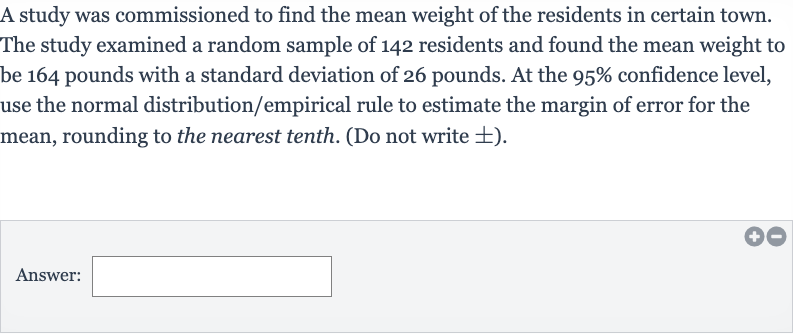AI tutor
Welcome to Bytelearn!
Let’s check out your problem:

A study was commissioned to find the mean weight of the residents in certain town. The study examined a random sample of residents and found the mean weight to be pounds with a standard deviation of pounds. At the confidence level, use the normal distribution/empirical rule to estimate the margin of error for the mean, rounding to the nearest tenth. (Do not write ).Answer:
Full solution
Q. A study was commissioned to find the mean weight of the residents in certain town. The study examined a random sample of residents and found the mean weight to be pounds with a standard deviation of pounds. At the confidence level, use the normal distribution/empirical rule to estimate the margin of error for the mean, rounding to the nearest tenth. (Do not write ).Answer:
- Understand the problem: Understand the problem and what is being asked.We need to calculate the margin of error for the mean weight of the residents in a town at the confidence level using the normal distribution/empirical rule.
- Identify the formula: Identify the formula to calculate the margin of error using the standard deviation and the z-score for the confidence level.The margin of error () can be calculated using the formula , where is the z-score corresponding to the confidence level, is the standard deviation, and is the sample size.
- Find the z-score: Find the z-score corresponding to the confidence level.For a confidence level, the z-score is typically . This value is obtained from a z-table or standard normal distribution table.
- Calculate the margin of error: Calculate the margin of error using the given values.We have the standard deviation = pounds, the sample size = , and the z-score for % confidence = .Now, plug these values into the formula:
- Perform the calculations: Perform the calculations.First, calculate the denominator:Now, divide the standard deviation by the square root of the sample size:Finally, multiply this result by the z-score:
- Round the margin of error: Round the margin of error to the nearest tenth. rounds to when rounded to the nearest tenth.
More problems from Use normal distributions to approximate binomial distributions
QuestionGet tutor help
QuestionGet tutor help
QuestionGet tutor help
QuestionGet tutor help
QuestionGet tutor help
QuestionGet tutor help
QuestionGet tutor help
QuestionGet tutor help
QuestionGet tutor help
QuestionGet tutor help
